Part 1
Part 2
Part 3
Part 4
Part 5
This report covers:
- One-piece adjustables
- One-piece mounts with droop compensation
- Bullseye ZR
- Burris XTR Signature rings
- Sportsmatch adjustables
- Summary
This series has looked at scope rings, but I thought I was done and hadn’t even touched on the subject of adjustable rings. Today we look at the more advanced adjustable scope rings.
One-piece adjustables
BB prefers two-piece rings in most situations, because one-piece rings limit the scope mounting options. But one-piece rings do have two advantages over two-piece. Assuming they are made well, one-piece rings don’t have the alignment issues that two-piece rings can have. Once the ring(s) are mounted on the rifle, the front and rear rings should align well. With two-piece rings that can sometimes be a problem.
The other advantage is that one-piece rings don’t have to have a gimbal on the front ring. As long as the ring base can pivot or the front and rear rings are on the same base bar, the rear of the scope can go up and down with no danger to the scope tube.
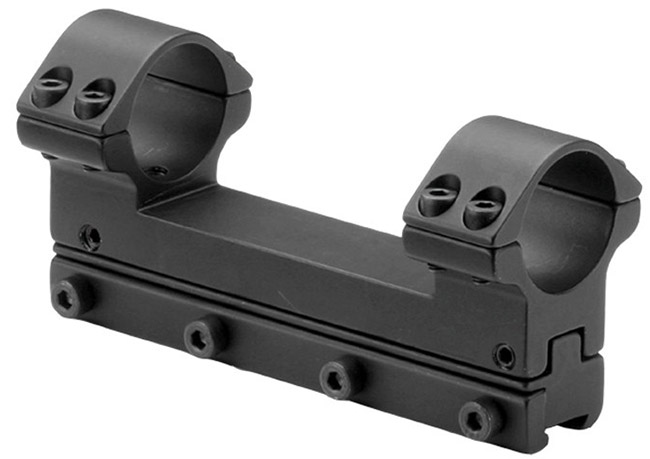
Sportsmatch one-piece adjustable rings.
The one-piece adjustable rings are made for barrel droop — in case your rifle has it. In case? If it doesn’t droop it is a rare bird! The question isn’t WHETHER it droops, but does it droop so much that you have to do something about it, beyond just cranking your scope’s elevation adjustment higher.
One-piece mounts with droop compensation
Besides adjustable scope mounts there are one-piece mounts that droop toward the front of the gun. In other words the scope rings slant downward, ever-so-slightly.
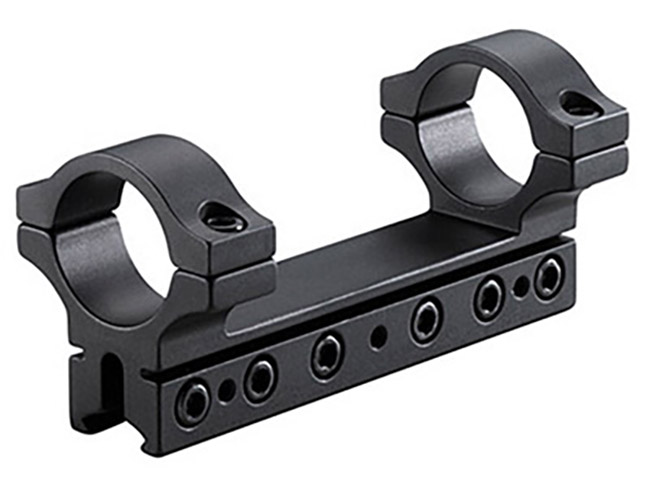
This BKL one-piece scope mount doesn’t adjust, but it slants downward by 0.007-inches rear to front.
The important thing with this type of mount is to always attach it so it slants down in front and not up. Unless you have a unicorn air rifle that needs its shots to be lowered, this kind of mount should only be attached one way.
Oh, and one more point — the description on the Pyramyd AIR web page talks about DROP compensation for this scope mount. That should read droop compensation. Drop compensation is a meaningless term.
Bullseye ZR
Then there is the Bullseye ZR (for zero recoil?) one-piece scope mount that has 0.004-inches of droop compensation, plus a spring-loaded ring base that compensates for the rifle’s recoil, and rings with inserts that work for both one-inch and 30 mm scope tubes.
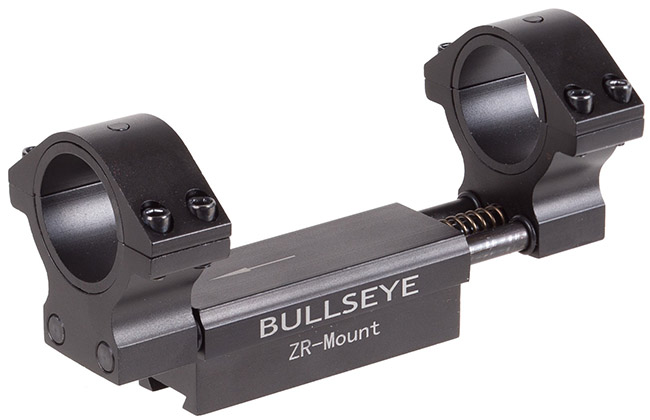
The Bullseye ZR scope mount. The springs are to cancel the effects of recoil.
The first and third features are useful. BB has no experience with the spring-loaded airgun scope base, but he does have some with heavy recoiling centerfire rifles. The target scopes sold by Lyman, Redfield and others have springs on the scopes. These scopes slide within their scope rings and the springs are there to push the scope back into battery (their starting position) after each shot. There are also similar and less expensive target scopes that have no springs and must be manually pushed back into battery. These mounts do work to cancel the effects of recoil on the scopes.

This Lyman Super Targetspot scope has a coiled spring to push the scope back into battery after each shot. As you can see, the tension of the resetting spring can be adjusted for lighter or heavier recoil.
Windage adjustment is possible for a one-piece scope mount, but it isn’t common. Sportsmatch makes a one-piece mount that is adjustable. But one-piece adjustables isn’t the way shooters are going. Instead they go for two-piece adjustable scope rings that adjust in both directions — just like the B-Square rings I presented in part 5 but more refined.
Burris XTR Signature rings
I will now present two different approaches to both elevation and windage adjustable 2-piece scope rings. First are the Burris XTR Signature rings. This is a two-piece ring set that comes with eccentric inserts that allow you to raise, lower and move the scope tube left and right — on either scope ring. The way they do it puts no strain on the scope tube and really does do the job.
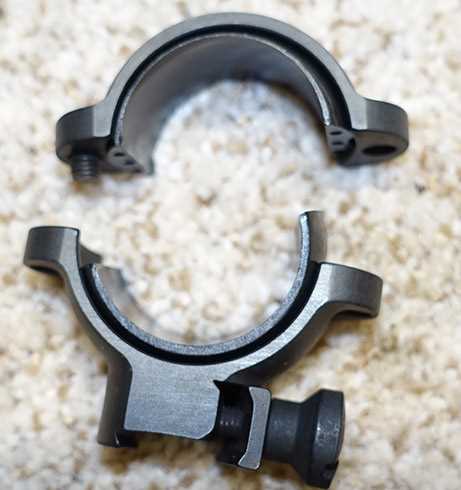
The inserts for these Burris rings can be moved all around the inside of the rings to point the scope tube in any direction you want. This view shows how the inserts fit inside the ring cap and saddle. By rotating the inserts you also get left-right adjustment.
The Burris scope rings really do work well, but they are almost impossibly fiddly to learn how to use correctly. Setting up a scope with them takes a very long time with many trials. But once you get them set up correctly they hold in place and do the job — at least with recoilless precharged pneumatic guns.
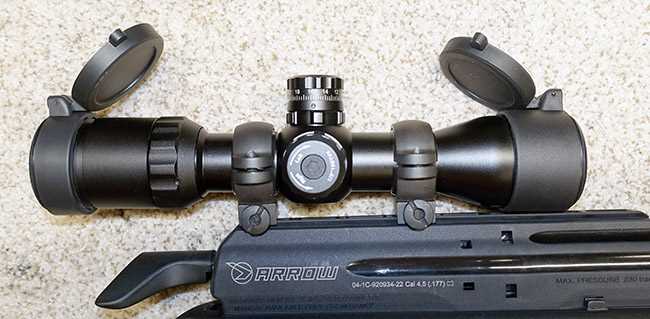
The Burris Signature rings did angle the scope downward on the Gamo Arrow. They also allowed the 3/4-inch rearward positioning of the scope I was looking for.
Sportsmatch adjustables
Sportsmatch also makes two-piece scope rings that adjust for both windage and elevation. I have a set mounted in my Air Arms S510XS rifle and I have vowed never to remove them — though the temptation has been great. The temptation is great because in my opinion, these are the best adjustable scope mounts on the market. I just wish I had more of them.
Summary
We have come a long way in the world of scope mounts in the past 70 years. When the scope ring revolution started in the 1950s, airguns were never scoped. Today they nearly always are. What will the next 20 years bring?


Tom,
Do you think you can convince Leapers to create an affordable line of adjustable mounts?
Siraniko
Siraniko,
I wondered that myself. Now that they are into bringing out their Integrix line with 34mm tubes there might be a chance.
BB
Like Meopta, I am afraid that the Integrix is beyond my budget. I am doing good to swing the occasional “cheap” Hawke. Most of my scopes are UTG, some of which have some pretty nice glass and reticles.
I have a Bullseye ZR-Mount. They are made by the new Diana Conglomeration. It does NOT have the coveted 3R rating. There is too much movement allowed after the scope/mount return to battery. I have been told by Hector Medina that he can tune them so that is no longer an issue, but how much does that cost? Mine are Gen 3. They have not worked it out yet? If you REALLY must have one, I will sell you mine real cheap!
As for the two-piece Sportsmatch fully adjustable rings. I have a set and they do have the coveted 3R rating. If you have the finesse, you can center your scope adjustments and zero your scope by adjusting the mounts. They may be expensive, but they are REAL nice! Be warned, if you should get a set, you will then want them on all of your scopes.
I have a couple of adjustable 11mm to Picatinny adapters that I bought from PA. Once you learn to use them properly, they work nice also.
/product/1-piece-adapter-base-9-11mm-dovetail-to-weaver-extension?a=8496
/product/hawke-sport-optics-1-pc-elevation-adapter-3-8-to-weaver-rail?a=4163
BB
Thanks for a very informative series. I have several of the one-piece Sportsmatch adjustable rings. They certainly work well and so far I haven’t had a scope/gun issue that required their two-piece version. If I do I know where to get them.
Deck
BB,
Keith (of 68 Whiskey channel) is a long range airgun shooter who dials the scope’s elevation to suit the trajectory.
Because of droop, the mechanical limits of scope adjustments and that he shoots at extreme ranges, Keith sets up the scope to maximize the elevation range by biasing the scope and then adjusting the mounts to compensate.
He dials the elevation to the mechanical minimum (then dials up a bit to take pressure off the erector tube), takes a couple of test shots to get on paper and then uses height adjustable rings to align the cross hairs to the near zero.
His approach makes sense for long range (100+ yards) shooting and I think I’ll setup my slug gun that way to try it out.
Hank
Hope this is not too far off-topic. I have a .22 target rifle with a grooved receiver that I want to get an adapter to use weaver style rings. No droop would be involved. Has anyone had any experience doing this ? What good quality adapters are available ? I’ve heard of Eagle Vision , but have not found much information. Thanks for your advice.
I have had really good results with this unit here: /product/utg-universal-dovetail-to-picatinny-weaver-adapter?a=7311
I have it mounted on my HW-30S along with a peep sight. I do most of my shooting with the peep sight, but having this pic/weaver rail mounted lets me keep a scope set up for it that I can just drop on it with quick mounts so I can be shooting with a scope in no time, and never need remove the peep (the peep sits rearward of this rail mounted to the tube’s dovetail). It works great for me – the only question is if it ends up too high for you (but you can control the total height with the rings too, if scoping it).
I am definitely a fan of the Burris XTR or Pos-a-lign scope rings. I use them on my long range air rifles and on my FT guns (PCPs and Springers). I bias the scope for droop initially, take some shots at my longest distances and then adjust the turrets to zero. As long as I don’t have to move the turrets very far from the mechanical center, I don’t go back and readjust the scope rings. But if needed, I will readjust by substituting a greater offset ring, or rotating the rings in the mounts, or changing the spacing between the rings to alter the droop (farther apart = less droop, closer together = more droop) according to standard trigonometry. I have not had these rings slip on a springer using the XTR model (https://www.burrisoptics.com/mounting-systems/rings/xtr-signature-rings) that has multiple clamp screws. I prefer these rings over the Sportsmatch, because they will never move because there are no screws that are used to hold the position fixed once it is set. All adjustable screws for windage and elevation adjustment have the possibility (or tendency) to loosen and affect the scope settings.
I have one of those Bullseye ZRs (real Diana, not the cheap clone), on a Hatsan 125. Yes, it is rather fiddly to mount, where a trick seems to be to keep that one mounting screw that holds the stop pin sloppy-loose until all is aligned on the dovetail and the pin finds the stop hole. Out of the box the recoil rails needed a bit of adjusting and all the little hex head screws needed tightening to hold together, not stick and return to battery consistently. That said, I shoot better with it and a scope than with a peep sight, and it does seem to protect the scope from a violent beating. The ZR mount doesn’t look like it would handle leaves and dirt though, so maybe it isn’t the best on a hunting gun.
For all you Fusiladores Frugales out there, the Dragonfly Mk2 .177 is finally on Pyramyd’s Refurbished page!
Mike
B.B. and USA Readership,
Public Service Announcement follows:
sta·re de·ci·sis
https://policelegal.wordpress.com/2010/07/06/federal-conviction-overturned-because-an-air-gun-silencer-is-not-a-firearm/
In the US Legal system a thing refered to as legal precedence sta·re de·ci·sis exists. It basically means that the rulings of a Court of Law can be used to overturn a false action by law enforcement or governmental agencies.
The Case linked to above is just such a case.
I hope DonnyFL has competent legal representation!
Let’s Go Brandon…got any more SCI Documents in your sock drawers or garage?
shootski
Thanks for sharing that, Shootski. Maybe airgun moderators/silencers, whatever one calls them, should be designed so they cannot be installed on a firearm but that is probably not practical. Still better to elect those who believe the guards must be guarded and will implement the necessary safeguards to ensure that happens.
Modern ELCAN scopes put the adjustments into the scope base. I wonder why this isn done with all scopes. It has a number of advantages. The lenses stay perfectly aligned, there’s ample room for elevation..
Mel,
Adjustable mounts were the way scopes were adjusted a century ago, too. It is the best way.
BB
In theory, having non adjustable scopes and adjustable bases would save a lot of money. The scopes would be substantially cheaper, and one could upgrade the scope while keeping the adjustable mount.